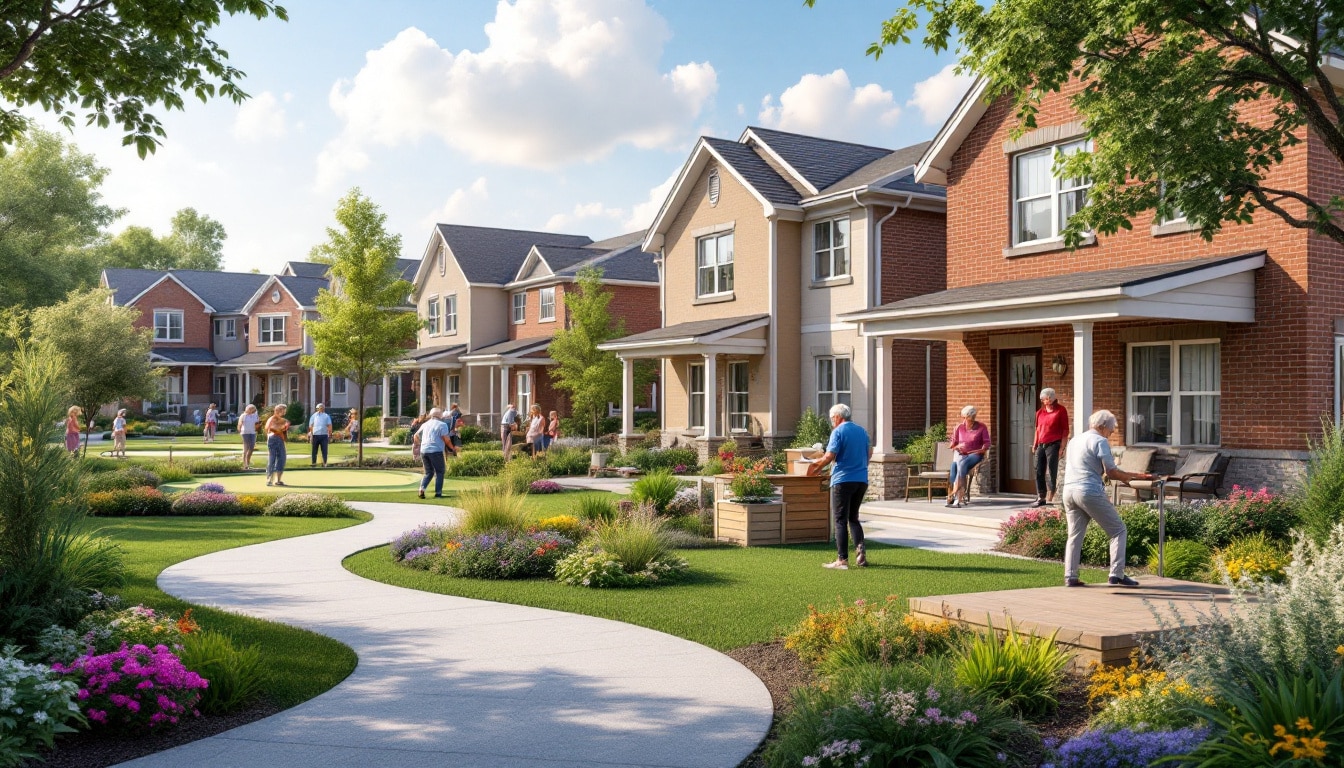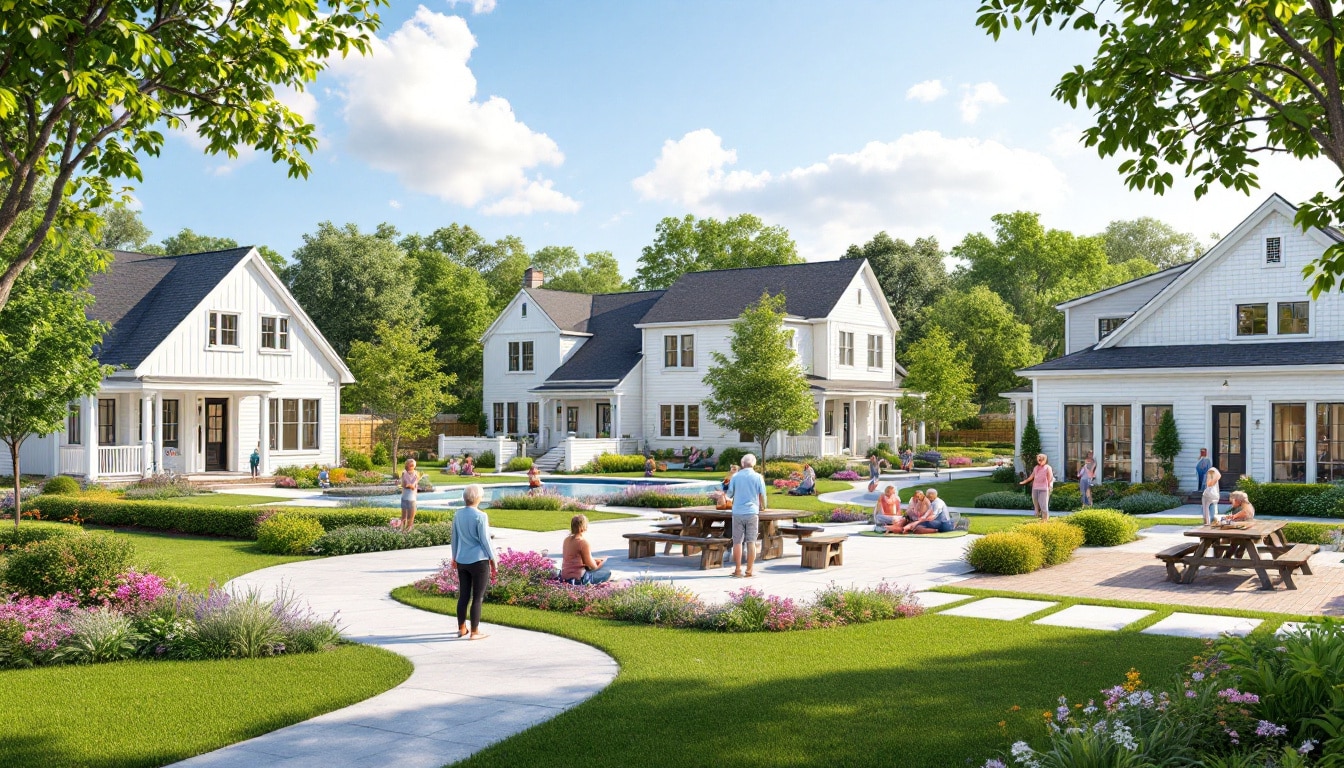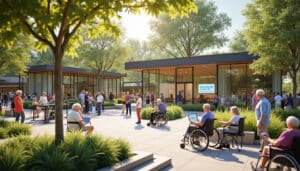“`html
Apartments for seniors offer a modern and tailored solution to the needs of the elderly. Specifically designed to promote independence, they combine comfort and safety. With a variety of options available, everyone can find a home that suits them.
As we age, our housing needs evolve, prioritizing safety, convenience, and a sense of community. Senior apartments perfectly meet these requirements by offering tailored environments and a variety of services. Whether it’s an affordable solution thanks to government programs or market-rate housing, there is an option for every financial situation. These communities often offer fitness centers, social activities, and sometimes even medical services, enabling seniors to stay active and engaged. Living in such an environment not only promotes mental and social health but also overall well-being by reducing feelings of loneliness. Moreover, the proximity of medical care becomes a major asset, ensuring quick assistance when needed. By understanding the different options available, it becomes easier to choose the type of housing that best meets one’s expectations and lifestyle.
What is a senior apartment?
Senior apartments are intended for elderly citizens who wish to live independently without the need for permanent caregivers. These residences offer an environment suited to seniors with features such as elevators, easily accessible studio layouts, grab bars, and walk-in showers, allowing residents to live freely and safely. Some housing options also include short-term services like transportation or housekeeping. These apartments are often subject to age restrictions to create a cohesive community, thus facilitating bonding and reducing feelings of loneliness.
The benefits of living in a senior community
Joining a senior community can significantly improve social and mental health. Regular interactions during organized events, group activities, and in communal spaces help prevent loneliness, isolation, and depression, which are common challenges among older adults living alone. Being part of a community fosters a sense of belonging and emotional support, contributing to reduced anxiety and stress. Additionally, constant interaction with peers stimulates cognitive health by encouraging seniors to stay mentally active and socially connected.
Senior apartments vs. retirement communities
While the terms “senior housing” and “retirement communities” are often used interchangeably, these types of residences meet different needs. Senior apartments provide housing in a tailored environment, while retirement communities offer a comprehensive range of services and activities similar to those found in a resort. The latter includes social events, dining services with meal plans, fitness centers, and even game rooms or clubs. Furthermore, they often employ medical staff on-site for memory care and home services, thus providing additional support to residents.
Senior apartments for those aged 55 and older
Senior apartments for individuals aged 55 and older present one option among others for independent senior housing. These communities provide relaxed environments with shared amenities such as fitness centers, social events, and sometimes clubhouses. They do not offer medical or personal care, making them ideal for active seniors wishing to live near their peers.
Income-based senior apartments vs. market-rate apartments
When searching for senior apartments, you will likely encounter terms such as “income-based” and “market-rate.” Income-based apartments are priced based on the residents’ income, often with rent capped at 30% of the adjusted gross income. These residences are usually supported by government grants and nonprofit organizations. In contrast, market-rate apartments are not covered by government assistance, and their cost is determined by factors such as location, size, amenities, and local property taxes.

What is an affordable senior residence?
Affordable senior residences are housing solutions specifically designed for elderly people wishing to live independently while benefiting from tailored services. These residences offer a secure and friendly environment, enabling seniors to maintain their autonomy while having access to various amenities. Unlike luxury residences, affordable residences stand out for their more accessible rates, often subsidized by government programs or nonprofit organizations.
These housing options meet the specific needs of seniors, such as accessibility of facilities, proximity to medical services, and the presence of communal spaces that encourage social ties. By choosing an affordable senior residence, elderly individuals can enjoy a suitable living environment without straining their budget. Furthermore, these residences often offer flexible options, ranging from independent living with à la carte services to packages including more extensive assistance based on individual needs.
Another major advantage of affordable senior residences is the possibility of integrating into a community that shares similar interests and lifestyles. This facilitates social bonding, thereby reducing the risk of isolation, a common concern among older individuals. In summary, affordable senior residences offer a balanced solution between autonomy, safety, and friendliness, while remaining financially accessible.
What types of housing are available for seniors?
There are several types of housing suitable for seniors, each addressing specific needs. Among the most common options are senior living apartments, which offer independent living with additional services such as maintenance, security, and social activities. These apartments are generally designed with features that facilitate mobility, such as wide corridors, access ramps, and adapted bathrooms.
Nursing homes offer another option, providing a higher level of care. They are ideal for seniors requiring daily assistance or regular medical care. These facilities have qualified medical staff and offer personalized care services, thereby ensuring tailored health monitoring for residents.
For seniors who are still independent but wish to live in a community environment, assisted living communities are an excellent alternative. They provide light support, such as help with household tasks, while allowing residents to maintain their independence. These communities also emphasize social interactions and the organization of recreational activities, thus promoting a high quality of life.
Lastly, intergenerational co-housing is gaining popularity, allowing seniors to live with individuals from different generations. This type of housing fosters exchange and mutual support, creating an enriching environment for all residents. Each type of housing offers unique benefits, allowing seniors to choose the option that best matches their needs and lifestyle.
How to finance your senior residence?
Financing a senior residence can be done in several ways, depending on the financial situation of each individual. One of the first options to consider is the use of personal savings. Many seniors have personal funds that they have saved throughout their professional lives, which they can utilize to cover housing expenses.
Social benefits and aids represent another important source of financing. Programs such as the Personalized Autonomy Allowance (APA) in France can help cover part of the costs associated with living in a senior residence. These aids are often based on income and the specific needs of the senior, making the stay more affordable.
Mortgage loans or bridging loans can also be considered, especially if the senior owns property they wish to sell or mortgage to fund their residence. These financing options allow for quick mobilization of funds, thus facilitating the transition to a new residence.
Finally, one can benefit from governmental or charitable aid. Some residences are subsidized, significantly lowering costs for residents. It is advisable to inquire with local social services or specialized associations to learn about available options.
It is essential to carefully assess one’s financial resources and compare the different financing options to choose the most suitable solution. Rigorously planning finances ensures a serene stay without financial worries in a senior residence.
What government aids exist for senior housing?
Several government aids are available to help seniors finance their living arrangements in a senior residence. One of the main aids in France is the Personalized Autonomy Allowance (APA), intended for dependent elderly individuals. This allowance helps cover part of the housing and support service costs, thus facilitating access to adapted residences.
The Retirement Savings Plan (PER) can also be used to finance senior housing. By capitalizing on the saved funds, seniors can have a financial reserve for covering residence expenses. Additionally, certain tax provisions allow for the deduction of interest on loans related to real estate financing, making repayment more affordable.
The Solidarity Fund Aids represent another source of support. These aids are intended for seniors with modest income and help subsidize the costs of living in a senior residence. Eligibility conditions vary based on departments and the resources of the applicant.
Finally, the Tax Credit for Energy Transition (CITE) can be advantageous for seniors renovating their homes to make them more accessible and secure. Although this tax credit is not directly intended for financing residences, it can lower the overall cost of necessary modifications.
To benefit from these aids, it is advisable to contact local social services or consult official government websites. A good understanding of the available aids enables the maximization of resources and makes living in a senior residence more affordable.
How to choose the best senior residence suited to your needs?
Choosing the best senior residence involves considering several essential criteria to meet the specific needs of each individual. First of all, it is crucial to assess the level of assistance required. Some seniors may require daily help with household tasks or medical care, while others may be fully independent and prefer an independent living environment.
The available budget is also a determining factor. It is important to compare the rates of different residences and check what is included in the price, such as dining services, cleaning, or social activities. Some residences offer all-inclusive packages, which can simplify financial management.
The geographical proximity of the residence is another aspect to consider. Being close to family, friends, or favorite places can significantly improve quality of life. In addition, proximity to medical services and essential infrastructure like shops and public transportation is crucial for comfortable daily living.
The facilities and services offered must also be evaluated. Residences offer a variety of amenities such as gyms, relaxation areas, libraries, or gardens. It is important to choose a residence that provides enriching activities and promotes the residents’ physical and mental well-being.
Finally, the reputation and reviews of current residents can provide valuable information about the quality of the residence. Visiting multiple facilities, talking with residents and staff helps to get an accurate idea of the atmosphere and satisfaction level of the inhabitants. Taking time to choose carefully ensures a successful transition and a comfortable life in the chosen residence.
What amenities and services are offered in a senior residence?
The amenities and services offered in a senior residence vary by facility, but some services are common and aim to improve residents’ quality of life. One basic service is security, with devices such as alert systems, surveillance cameras, and staff available 24/7 to ensure residents’ peace of mind.
Catering is often included, with balanced meals prepared on-site. Some residences also offer personalized meal options to accommodate residents’ specific diets. Shared kitchens or integrated restaurants provide opportunities for socializing while enjoying varied meals.
Housekeeping and laundry services are generally included, thus facilitating the daily lives of residents. These services allow seniors to focus on their activities and social interactions without worrying about household tasks.
Residences also offer a multitude of recreational and social activities, such as creative workshops, cultural outings, physical activities like gentle gymnastics or yoga, and themed evenings. These activities help maintain cognitive and physical abilities while strengthening social ties among residents.
Some facilities also provide medical services on-site or nearby, such as nursing consultations, rehabilitation care, or chronic disease management programs. These services ensure regular medical monitoring and meet the specific health needs of residents.
Finally, communal spaces such as libraries, game rooms, gardens, or fitness centers are often available, creating an environment conducive to relaxation and social interactions. These facilities contribute to an active and fulfilling community life.
How to find a senior residence near you?
Finding a senior residence near your home requires a methodical approach and the use of various available resources. The first step is to determine your location criteria, taking into account the proximity of your family, friends, and essential services like hospitals, pharmacies, and shops.
Use online search tools to identify available residences in your area. Specialized websites allow you to filter options based on your preferences in terms of services, budget, and type of housing. Comparing online offers gives you an overview of possibilities and helps you select the facilities that best meet your needs.
It is also recommended to consult local listings and visit social centers or town halls, which may have information about residences available in your sector. Brochures and practical guides distributed by these agencies provide valuable details about housing options for seniors.
Participating in open house days or fairs dedicated to senior residences is an excellent way to discover multiple facilities at once. These events allow you to meet staff, visit locations, and ask current residents questions about their experiences and the quality of services offered.
Recommendation networks also play a key role in finding a nearby residence. Talk to healthcare professionals, social workers, or other seniors who have already chosen a residence. Their advice and recommendations can guide your search toward reliable and appreciated establishments.
Finally, don’t forget to check the certifications and accreditations of the residences you are considering. These labels ensure compliance with quality and safety standards, thus guaranteeing a healthy and suitable living environment. By combining these different approaches, you maximize your chances of finding a senior residence close to home that perfectly meets your expectations and needs.
Do senior residences accept pets?
The possibility of keeping a pet in a senior residence largely depends on each establishment’s specific policies. Many residences recognize the importance of animals for residents’ emotional well-being and choose to welcome pets, including dogs and cats.
However, some residences may impose restrictions concerning size, breed, or number of pets allowed. For instance, they may limit pets to a certain weight or ban breeds considered potentially aggressive. It is essential to inquire in advance about these policies to avoid disappointment.
Service animals, such as guide dogs for the visually impaired or therapy animals, are generally accepted in all residences, in accordance with applicable laws. They play a crucial role in providing daily assistance and enhancing residents’ quality of life.
Before finalizing a residency choice, it is advisable to discuss specific pet-related requirements with the facility’s management. Some residences may require documentation proving the pet’s vaccination and health or may demand an additional deposit.
Moreover, it’s essential to consider the space available in the apartment and the facilities of the residence, such as outdoor areas suitable for dog walking. A residence well-suited for pets not only ensures the comfort of residents but also the well-being of the animals themselves.
In summary, although many senior residences accept pets, it is crucial to check each facility’s specific policies and ensure that the animal’s needs are also taken into account. A pet-friendly residence contributes to a more fulfilling and enriching life for seniors.
Are senior residences secure?
Security is a top priority in senior residences, ensuring a protected and serene environment for residents. Several measures are implemented to guarantee this security, both in terms of infrastructure and services offered. Among the commonly installed security features are emergency alert systems, surveillance cameras in common areas, and controlled access to limit entry to authorized residents and staff only.
Residences also have security personnel present 24 hours a day, ready to intervene if needed. This staff ensures the tranquility of the premises and provides a quick response in case of incidents or emergencies. Additionally, regular security routines, such as fire evacuation drills, are organized to prepare residents and staff to react efficiently when needed.
Adapted infrastructure also plays a key role in the security of senior residences. Buildings are designed to minimize fall risks with non-slip floors, access ramps, secure elevators, and adequate lighting in corridors and common areas. Rooms are equipped with grab bars and other features that facilitate mobility and daily safety for residents.
Furthermore, many residences offer health and medical care services on-site or nearby, ensuring quick access to care when needed. The presence of medical or paramedical staff enhances the security of residents by providing constant monitoring of their health status and rapid intervention in case of issues.
Lastly, transparent communication between residents, staff, and family members is essential for ensuring optimal security. Residences establish effective communication channels, allowing residents to promptly report any issues or concerns. This proactive approach contributes to creating a secure environment where seniors can live with confidence and serenity.
What criteria should be considered when visiting a senior residence?
During the visit to a senior residence, it is important to take into account several essential criteria to ensure that the establishment perfectly meets the needs and expectations of potential residents. First, observe the overall atmosphere of the residence. A clean, well-maintained, and welcoming environment is a sign of seriousness and professionalism. Pay attention to how the staff interacts with residents and how they seem to feel in their environment.
Check the quality of the facilities, such as common areas, bedrooms, kitchens, and bathrooms. Ensure that the housing is suitable for your needs in terms of size, accessibility, and comfort. Test whether equipment like elevators, ramps, and grab bars are in good condition and well-placed to facilitate mobility.
Evaluate the services and amenities offered by the residence. Request detailed information about dining services, recreational activities, available medical care, and maintenance services. Verify whether these services are included in the price or if they require additional charges. A wide range of services can greatly enhance the quality of life within the residence.
Ask about the security policies and emergency measures in place. Inquire about the presence of security staff, alert systems, and protocols in case of emergencies. A well-secured residence is crucial for ensuring your peace of mind and personal safety.
Ensure you understand the cost structure. Request a detailed estimate that includes all possible costs, such as rent, charges, additional services, and any potential price increases. Compare these costs with your budget to avoid financial surprises.
Finally, if possible, talk to current residents. Their feedback offers an authentic perspective on daily life in the residence, the quality of services, and residents’ overall satisfaction. These exchanges can help you make an informed decision and choose a residence that truly meets your expectations.
What are the advantages of living in a senior residence?
Living in a senior residence presents numerous advantages that contribute to the well-being and quality of life of residents. One of the main benefits is the increased security. Residences are equipped with advanced security devices and have personnel available 24/7, offering valuable peace of mind to residents and their families.
The friendliness and sense of community are also major assets. Residences regularly organize social activities, workshops, and events, fostering interactions between residents and helping to build strong relationships. This social dimension reduces the risk of isolation and promotes a sense of belonging and camaraderie.
The all-inclusive services are another significant advantage. Dining, housekeeping, laundry, and sometimes even health care are included in the package, simplifying daily management for residents. This allows seniors to focus on what truly matters: enjoying their retirement in peace.
The proximity of medical care is also a key advantage. Many residences partner with local health institutions, facilitating quick access to medical consultations, rehabilitation care, and specialized health services. This accessibility is crucial for ensuring prompt and effective care when needed.
Finally, the flexibility of senior residences allows for adaptation to the evolving needs of residents. Whether you need more or less assistance over time, the residence can adjust its offered services to match your current situation. This adaptability guarantees ongoing support while respecting individual autonomy and preferences.
In summary, living in a senior residence offers a unique combination of security, friendliness, practical services, and medical proximity, thereby contributing to a high and fulfilling quality of life for elderly individuals.
How to apply for an affordable senior residence?
To apply for an affordable senior residence, it is important to follow a series of well-defined steps to ensure a smooth transition that meets your needs. The first step is to assess your needs in terms of housing, services, and budget. Determine which type of residence suits you best, whether it be independent living, a nursing home, or an assisted living community.
Next, conduct a thorough search for available residences in your area. Use online resources, consult specialized directories, and contact local senior housing agencies. Compile a list of potential residences based on your location criteria, budget, and offered services.
Contact the selected residences to obtain further information and schedule tours. During your visits, ask detailed questions about costs, included services, security policies, offered activities, and living conditions. Take notes and compare the different options to identify the one that best meets your expectations.
Then, prepare the necessary documents for your application. This may include identification documents, proof of income, medical records, and personal references. Some residences may also require specific forms or additional interviews to assess your eligibility.
Fill out the application forms for the residences of your choice. Be sure to respect submission deadlines and provide all required documents to avoid delays in processing your application. Some residences may have waiting lists, so it is important to submit your request as early as possible.
Finally, once your application is accepted, proceed to finalize the contract. Read the terms and conditions carefully before signing, and don’t hesitate to ask questions if any points are unclear. Make sure you fully understand your rights and responsibilities as well as those of the residence.
By following these steps methodically, you optimize your chances of finding and applying for an affordable senior residence that perfectly matches your needs and expectations, ensuring a smooth transition and an optimal quality of life.
What are the psychological impacts of living in a senior residence?
Living in a senior residence can have various psychological impacts, which vary depending on the personality of the residents, their health status, and the quality of social interactions within the residence. One of the most notable positive effects is the reduction of social isolation. By being surrounded by other seniors, residents can easily form friendships and participate in community activities, fostering a sense of connection and belonging.
The security and stability offered by senior residences also contribute to better mental health. Knowing that assistance is available when needed provides essential peace of mind, thereby reducing stress and anxiety related to the uncertainties of daily life. This emotional stability allows residents to focus on enriching and enjoyable activities.
The social and recreational activities organized within residences play a crucial role in maintaining cognitive and emotional health. Participating in creative workshops, seminars, or excursions stimulates the mind, prevents cognitive decline, and brings joy and satisfaction to daily life.
However, it is important to note that some seniors may experience feelings of loss of independence or nostalgia when leaving their family home to move into a residence. It is essential to prepare for this transition by openly discussing emotions and implementing strategies to maintain ties with family and friends.
Moreover, the quality of relationships with staff and other residents can greatly influence the psychological experience of seniors. Attentive and well-trained staff, along with a respectful and inclusive environment, foster a positive climate where residents feel valued and supported.
In summary, living in a senior residence can significantly improve psychological well-being by reducing social isolation, offering a secure environment, and providing stimulating activities. However, it is crucial to manage emotional transitions carefully and promote healthy and enriching relationships within the residential community.
Do senior residences offer options for personalizing living spaces?
Yes, many senior residences offer options for personalizing living spaces to meet the individual preferences of residents. This personalization allows seniors to create an environment that reflects their personality and tastes, thereby fostering a sense of belonging and comfort. Personalization options may include choices of colors, furniture, decorations, and specific arrangements within the apartment.
The ability to customize one’s living space is essential for maintaining a certain level of autonomy and preserving residents’ personal identity. By arranging their space according to their preferences, seniors can feel more comfortable and at home, contributing to their overall well-being. Some residences even offer decorating assistance, where residents can benefit from the advice of professionals to optimize their living arrangement.
In addition to interior decoration, personalization can also extend to services and activities offered. Residences can provide flexible programs allowing residents to choose activities that interest them most, whether they be yoga classes, book clubs, crafts, or cultural excursions. This flexibility meets the diverse interests and needs of residents, making their stay more enjoyable and enriching.
Some residences also offer technological options to personalize the living experience. For instance, installing automated systems to control lighting, temperature, or security may be proposed, enabling residents to manage their environment more autonomously and comfortably.
Lastly, personalizing living spaces often includes the possibility of hosting guests or welcoming family members, which increases the feeling of freedom and flexibility. Residences generally feature well-appointed common areas and visiting rooms, fostering family interactions without compromising residents’ privacy.
In summary, personalizing living spaces in senior residences is a common practice that greatly contributes to enhancing residents’ quality of life, allowing them to feel at home and live satisfactorily and fulfillingly.
What are the selection criteria for senior residences?
The selection of a senior residence relies on several essential criteria to ensure that the chosen establishment perfectly meets the needs and expectations of future residents. Among these criteria, the first is often the level of care and assistance provided. It is crucial to determine whether the residence offers appropriate medical services, such as nursing care, rehabilitation, or palliative care, based on the senior’s health status.
The budget is another determining criterion. It is important to compare the costs of different residences, taking into account the included services and any potential additional fees. Some residences offer financing options or government aids, which can influence the final choice.
The geographic location also plays a crucial role in the decision. Living close to family, friends, or essential services such as hospitals and shops can greatly enhance quality of life. Additionally, proximity to cultural and recreational activities enriches the daily experiences of residents.
The quality of infrastructure is another aspect to consider. Inspect the living spaces, recreational facilities, security systems, and specific arrangements for individuals with reduced mobility. A well-maintained residence equipped appropriately ensures optimal comfort and a pleasant daily life.
The staff of the residence is also a key criterion. It is important to ensure that the staff is qualified, attentive, and available. Ongoing training and professionalism of the staff are indicators of the overall quality of the residence and its ability to meet residents’ needs.
Finally, the reputation of the residence and reviews from current and former residents provide valuable insights into overall satisfaction and the quality of services offered. Testimonials and online evaluations can offer an objective perspective on the experiences lived by residents.
By taking these selection criteria into account, seniors can make an informed choice and find a residence that offers a safe, comfortable, and enriching living environment that perfectly meets their personal expectations and needs.











